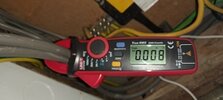Just started Level 3 C&G and we're doing cable sizing calcs. Using a previous years exam question.
We ran through a few examples of radial circuits, all well and good. Following this proceedure:
Work out total load on circuit from plan.
Work out design current. Ib.
Ib<In<It
Find suitable breaker that's bigger than the Ib.
Now find It, tabluated current, by using cable factors Ca, Ci, Cf and Cg.
Once we have It, look up the size of cable for the given reference method of installation, in this case, Single Phase multicore, Method B. using table F5i in the On Site Guide.
Finally, look up volts drop for the selected cable CSA and make sure its less that the allowable limits.
All well and good with the radial examples.
Then we come to a ring final power circuit. We're told that the design current is 23A and so a 32A breaker is to be used.
Applying cable factors totalling 0.8 we get an It of 40A.
If we look up 40A in table F5i in the OSG, we find that we need 10mm2 cable! How can this be right? Everyone uses 2.5mm2 and I would doubt that you could fit two10mm2 tails into a 13A socket terminal!
Even the lecturer was confused by this.
I assume that as the circuit is a ring, the current is halved somewhere in the calcs or is a ring circuit just an oddball requiring a different calc?
Any I going mad or missing something here? Any help most welcome!
We ran through a few examples of radial circuits, all well and good. Following this proceedure:
Work out total load on circuit from plan.
Work out design current. Ib.
Ib<In<It
Find suitable breaker that's bigger than the Ib.
Now find It, tabluated current, by using cable factors Ca, Ci, Cf and Cg.
Once we have It, look up the size of cable for the given reference method of installation, in this case, Single Phase multicore, Method B. using table F5i in the On Site Guide.
Finally, look up volts drop for the selected cable CSA and make sure its less that the allowable limits.
All well and good with the radial examples.
Then we come to a ring final power circuit. We're told that the design current is 23A and so a 32A breaker is to be used.
Applying cable factors totalling 0.8 we get an It of 40A.
If we look up 40A in table F5i in the OSG, we find that we need 10mm2 cable! How can this be right? Everyone uses 2.5mm2 and I would doubt that you could fit two10mm2 tails into a 13A socket terminal!
Even the lecturer was confused by this.
I assume that as the circuit is a ring, the current is halved somewhere in the calcs or is a ring circuit just an oddball requiring a different calc?
Any I going mad or missing something here? Any help most welcome!


